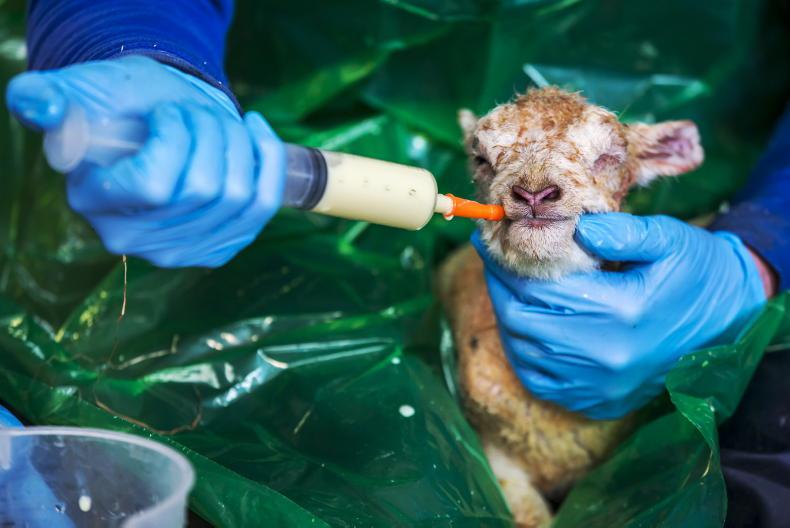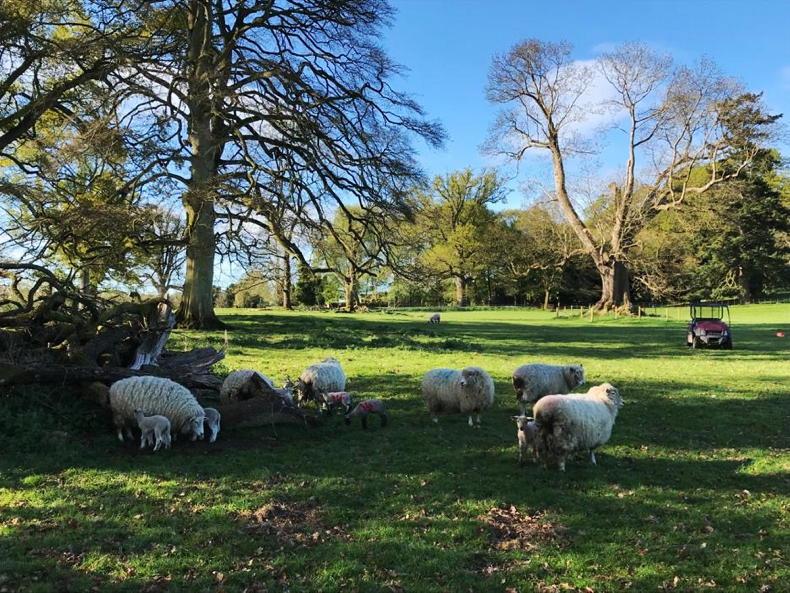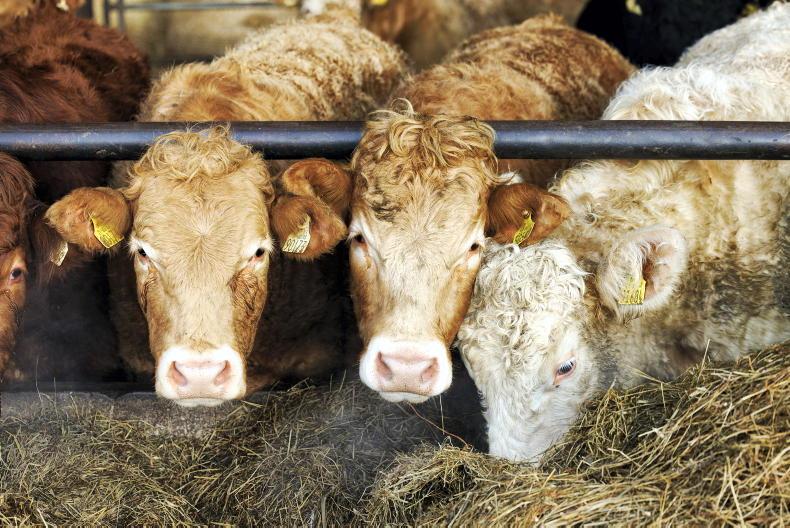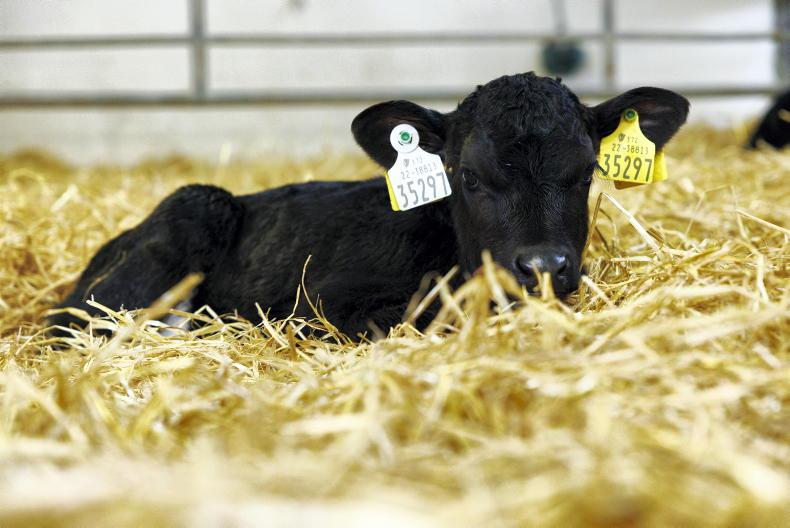Last week’s focus on lambing has generated many follow-on reader queries on topics ranging from outdoor lambing to colostrum alternatives and health issues such as preventative treatments for watery mouth. This week’s sheep pages and management notes address some of these queries and more will be addressed online in the coming days.
Grass growth has been pretty good on paddocks closed up first last autumn. The kinder weather has also meant I have had a chance to get out with some urea this week. Added to this I am in two minds about purchasing as many cattle as I usually do in spring given the high prices and am looking at the possibility of lambing some ewes outdoors to try and reduce labour and take some cost out of the system. Ewes are housed at the moment. When would I want to be letting them out and will I also need to supplement at grass?
There have been extensive studies carried out on outdoor lambing in the Agri-Food & Biosciences Institute (AFBI) in recent years. The organisation’s work showed that outdoor lambing can significantly reduce costs and labour input (typically 30% less labour) with grazed grass in the region of 30% cheaper on a per-kilogram basis than high-quality silage.
Furthermore, when managed correctly grazed grass has a 5% to 10% higher nutritional value than most high-quality grass silages and a nutritional value similar to an 18% protein ewe mix. Given suitable grazing conditions, ewes at grass will also be capable of consuming up to 50% more dry matter with a sufficient quantity of early spring grass easily capable of meeting the nutritional requirements of twin-bearing ewes.
The studies found that triplet-bearing ewes are capable of producing adequately sized lambs and sufficient colostrum without additional concentrates, provided there is adequate supply of quality grass available. If grass supplies are limited then it is advisable to supplement with 0.3kg to 0.5kg of concentrates in the final two weeks of gestation. Many farmers prioritise lambing triplet- and- single-bearing ewes indoors to facilitate cross fostering and twin-bearing ewes outdoors.
The timing of letting ewes out to grass is important from the perspective of ensuring grass supplies are not depleted too quickly and also in preventing overfeeding of ewes. The AFBI trials highlighted that when conditions are favourable, turning ewes out to short grass swards (3cm to 5cm) three to four weeks pre-lambing and stocking at a level sufficient to maintain this sward height should be sufficient to meet the ewes’ nutritional requirements without concentrates.
The target stocking rate will vary depending on grass growth rates, ground conditions/grass utilisation but in general a stocking rate of 12 ewes/ha (five ewes per acre) is the typical advice for a mid-March lambing flock.
Where there is a surplus supply of grass or ewes are released too early then there can be a risk that outdoor lambing will actually end up increasing the labour requirement. This is due to the birth of heavier lambs and more ewes requiring assistance, as detailed in Table 1.
As can be seen in the table, overfeeding ewes in late gestation had negative consequences on subsequent lamb performance.
One of my neighbours has recently converted to dairying and has told me I can bring away as much colostrum as I need for lambing. I am strongly considering taking him up on his offer but I think I read before or heard about issues in feeding cow colostrum to lambs – am I right in thinking this?
Yes, you are correct. While it is relatively rare, cow colostrum has been found to contain antibodies which are linked to the breakdown of red blood cells in lambs which can cause anaemia. Cow colostrum is generally the second choice as an alternative to ewe colostrum, with the first choice being colostrum from another ewe in the flock.

Ensuring each lamb receives some ewe colostrum where at all possible will deliver massive benefits in reducing the risk of health issues. / Philip Doyle
Where there are also cows on the farm, which is common on mixed sheep and suckler farms, then it is preferential to try and save colostrum from these cows. This is due to the fact that such colostrum will contain immunoglobulins (IgG) to farm-specific pathogens. Where using cow colostrum, pooling colostrum from a number of cows can help guard against anaemia as if one cow’s colostrum contains antibodies which harm red blood cells it will be diluted in a pooled sample and will reduce the risk.
As with any alternative to ewe colostrum, the optimum approach where possible is to try and ensure lambs have a supply of ewe colostrum first before topping up with the colostrum alternative.
For example, in triplet litters there is often a tendency to let stronger lambs suckle and feed a colostrum alternative to the smaller or weaker lamb.
The best approach would be to ensure each lamb has access to colostrum whether this be via suckling or stomach tubing, with the latter option providing the benefit of knowing what quantities are administered, and then top this up with a colostrum alternative.
I have ewes in poorer condition than I would like. They are not lambing until the end of March, have a lower scanning rate this year with an in-lamb rate of 1.1 lambs and I am wondering if feed buckets or molasses would be OK to keep them up until I bring them closer to home for lambing?
This unfortunately is a more common occurrence this year in many hill and lowland flocks. Feed buckets are generally marketed as a “complementary feeding stuff” and this describes them well. They are valuable in reducing the labour requirement and providing a constant supply of supplementary feed in difficult conditions but they will not replace or satisfy the full energy requirement.
Their role will depend on the volume and quantity of forage present. For example, if grass supplies or hill vegetation is depleted then access to silage/hay/haylage or concentrates will also be required to bridge the nutritional deficit. Similar to assessing compound or concentrate feeds, the energy content should be checked to determine the feeding value as this can vary significantly, as can the range and level of minerals included.

Molasses or feed buckets can help increase the energy intake but they will not satisfy nutrional requirements on their own.
Molasses is typically offered at a rate of 200ml to 250ml per day and again it can have a role in increasing the overall energy intake.
Again, it will only satisfy a component of the nutritional requirement and needs to be part of an overall feeding programme. The energy and protein content also varies and it is important to get a gauge of the feeding value when weighing up the options.
The value of buckets and molasses should be examined on an energy intake and costed relative to concentrates. An allowance can then be made for the labour saving element, but it is prudent to investigate the merits of feeding such alternatives versus concentrates/forage.
Last week’s focus on lambing has generated many follow-on reader queries on topics ranging from outdoor lambing to colostrum alternatives and health issues such as preventative treatments for watery mouth. This week’s sheep pages and management notes address some of these queries and more will be addressed online in the coming days.
Grass growth has been pretty good on paddocks closed up first last autumn. The kinder weather has also meant I have had a chance to get out with some urea this week. Added to this I am in two minds about purchasing as many cattle as I usually do in spring given the high prices and am looking at the possibility of lambing some ewes outdoors to try and reduce labour and take some cost out of the system. Ewes are housed at the moment. When would I want to be letting them out and will I also need to supplement at grass?
There have been extensive studies carried out on outdoor lambing in the Agri-Food & Biosciences Institute (AFBI) in recent years. The organisation’s work showed that outdoor lambing can significantly reduce costs and labour input (typically 30% less labour) with grazed grass in the region of 30% cheaper on a per-kilogram basis than high-quality silage.
Furthermore, when managed correctly grazed grass has a 5% to 10% higher nutritional value than most high-quality grass silages and a nutritional value similar to an 18% protein ewe mix. Given suitable grazing conditions, ewes at grass will also be capable of consuming up to 50% more dry matter with a sufficient quantity of early spring grass easily capable of meeting the nutritional requirements of twin-bearing ewes.
The studies found that triplet-bearing ewes are capable of producing adequately sized lambs and sufficient colostrum without additional concentrates, provided there is adequate supply of quality grass available. If grass supplies are limited then it is advisable to supplement with 0.3kg to 0.5kg of concentrates in the final two weeks of gestation. Many farmers prioritise lambing triplet- and- single-bearing ewes indoors to facilitate cross fostering and twin-bearing ewes outdoors.
The timing of letting ewes out to grass is important from the perspective of ensuring grass supplies are not depleted too quickly and also in preventing overfeeding of ewes. The AFBI trials highlighted that when conditions are favourable, turning ewes out to short grass swards (3cm to 5cm) three to four weeks pre-lambing and stocking at a level sufficient to maintain this sward height should be sufficient to meet the ewes’ nutritional requirements without concentrates.
The target stocking rate will vary depending on grass growth rates, ground conditions/grass utilisation but in general a stocking rate of 12 ewes/ha (five ewes per acre) is the typical advice for a mid-March lambing flock.
Where there is a surplus supply of grass or ewes are released too early then there can be a risk that outdoor lambing will actually end up increasing the labour requirement. This is due to the birth of heavier lambs and more ewes requiring assistance, as detailed in Table 1.
As can be seen in the table, overfeeding ewes in late gestation had negative consequences on subsequent lamb performance.
One of my neighbours has recently converted to dairying and has told me I can bring away as much colostrum as I need for lambing. I am strongly considering taking him up on his offer but I think I read before or heard about issues in feeding cow colostrum to lambs – am I right in thinking this?
Yes, you are correct. While it is relatively rare, cow colostrum has been found to contain antibodies which are linked to the breakdown of red blood cells in lambs which can cause anaemia. Cow colostrum is generally the second choice as an alternative to ewe colostrum, with the first choice being colostrum from another ewe in the flock.

Ensuring each lamb receives some ewe colostrum where at all possible will deliver massive benefits in reducing the risk of health issues. / Philip Doyle
Where there are also cows on the farm, which is common on mixed sheep and suckler farms, then it is preferential to try and save colostrum from these cows. This is due to the fact that such colostrum will contain immunoglobulins (IgG) to farm-specific pathogens. Where using cow colostrum, pooling colostrum from a number of cows can help guard against anaemia as if one cow’s colostrum contains antibodies which harm red blood cells it will be diluted in a pooled sample and will reduce the risk.
As with any alternative to ewe colostrum, the optimum approach where possible is to try and ensure lambs have a supply of ewe colostrum first before topping up with the colostrum alternative.
For example, in triplet litters there is often a tendency to let stronger lambs suckle and feed a colostrum alternative to the smaller or weaker lamb.
The best approach would be to ensure each lamb has access to colostrum whether this be via suckling or stomach tubing, with the latter option providing the benefit of knowing what quantities are administered, and then top this up with a colostrum alternative.
I have ewes in poorer condition than I would like. They are not lambing until the end of March, have a lower scanning rate this year with an in-lamb rate of 1.1 lambs and I am wondering if feed buckets or molasses would be OK to keep them up until I bring them closer to home for lambing?
This unfortunately is a more common occurrence this year in many hill and lowland flocks. Feed buckets are generally marketed as a “complementary feeding stuff” and this describes them well. They are valuable in reducing the labour requirement and providing a constant supply of supplementary feed in difficult conditions but they will not replace or satisfy the full energy requirement.
Their role will depend on the volume and quantity of forage present. For example, if grass supplies or hill vegetation is depleted then access to silage/hay/haylage or concentrates will also be required to bridge the nutritional deficit. Similar to assessing compound or concentrate feeds, the energy content should be checked to determine the feeding value as this can vary significantly, as can the range and level of minerals included.

Molasses or feed buckets can help increase the energy intake but they will not satisfy nutrional requirements on their own.
Molasses is typically offered at a rate of 200ml to 250ml per day and again it can have a role in increasing the overall energy intake.
Again, it will only satisfy a component of the nutritional requirement and needs to be part of an overall feeding programme. The energy and protein content also varies and it is important to get a gauge of the feeding value when weighing up the options.
The value of buckets and molasses should be examined on an energy intake and costed relative to concentrates. An allowance can then be made for the labour saving element, but it is prudent to investigate the merits of feeding such alternatives versus concentrates/forage.












SHARING OPTIONS